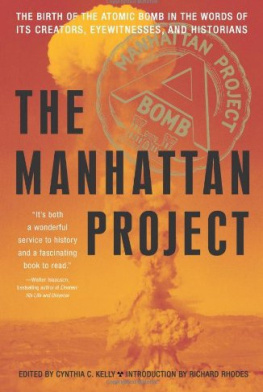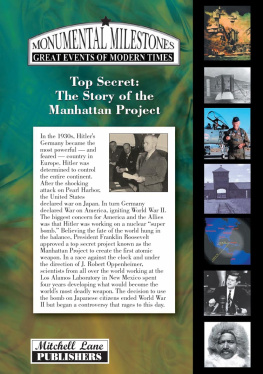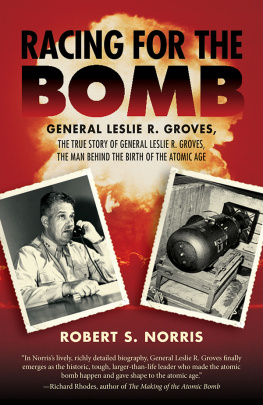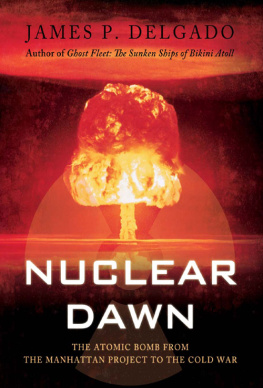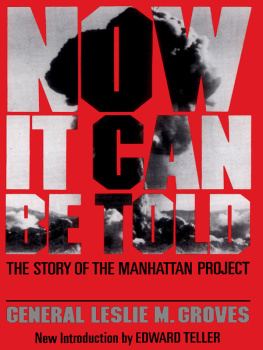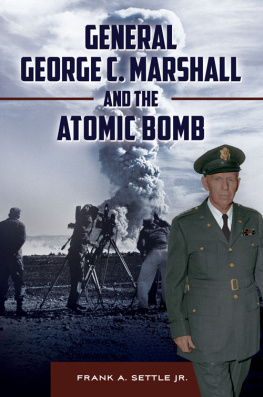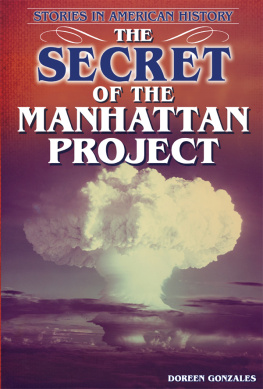The Manhattan Project
The Birth of the Atomic Bomb
in the Words of Its Creators,
Eyewitnesses, and Historians
Edited by Cynthia C. Kelly
President, Atomic Heritage Foundation
Introduced by Richard Rhodes

Copyright 2007 by the Atomic Heritage Foundation.
See pages 489-495 for additional text and art credits and permissions.
Those pages constitute a continuation of this copyright page.
All rights reserved. No part of this book, either text or illustration, may be used or reproduced in any form without prior written permission from the publisher.
ISBN-13: 978-1-57912-747-3
Library of Congress Cataloging-in-Publication Data
The Manhattan project: the birth of the atomic bomb in the words of its creators, eyewitnesses, and historians / edited by Cynthia C. Kelly.
p. cm.
Includes bibliographical references and index.
ISBN 978-1-57912-747-3
1. Manhattan Project (U.S.)History. 2. Atomic bombUnited States
History. I. Kelly, Cynthia C.QC773.3.U5M27 2007
355.8251190973--dc22
2007023984
Interior design: Cynthia Belinfanti
Cover design: Elizabeth Driesbach
Manufactured in the United States of America
Published by
Black Dog & Leventhal Publishers, Inc.
151 West 19 th Street
New York, New York 10011
Distributed by
Workman Publishing Company
225 Varick Street
New York, NY 10014
g f e d c b a
Acknowledgments
Thanks to all the Manhattan Project veterans and their family members, distinguished historians, novelists, artists and others whose diverse perspectives enrich and enliven this book. This project reflects the expertise of five award-winning Manhattan Project authors who served as our advisory team and were indispensable to the effort.
In addition to providing valuable advice, Richard Rhodes, author of The Making of the Atomic Bomb , wrote a masterful introduction. Robert S. Norris, author of Racing for the Bomb , retrieved numerous documents from his personal archives and created guides to the Manhattan Project sites in New York City and Washington DC. William Lanouette, author of Genius in the Shadows , shaped the sections on the moral and ethical dilemmas associated with the use of the bomb. Kai Bird made many excellent suggestions stemming from his work on American Prometheus and Hiroshimas Shadow . Andrew Brown, author of The Neutron and the Bomb, ensured that the British and their contributions are well represented.
This volume came into being because of the personal interest of J. P. Leventhal, president of Black Dog & Leventhal. Joseph Kanon suggested that Black Dog contact the Atomic Heritage Foundation and Laura Ross expertly guided its development. It was a great opportunity and pleasure to work with Black Dog on this publication.
Kathryn McPike and Jennifer Rea, Princeton Fellows, were responsible for translating the suggestions of the advisors into black-and-white content and did so with intelligence and professionalism. Colin Clay, Tim Malacarne, and Theresa Schlafly ably managed the Atomic Heritage Foundations many other projects. Also, we are grateful to Latham & Watkins for use of its high-tech conference space and thank Dorrie Nero for taking care of the logistics for the advisory teams meetings.
My personal interest in the Manhattan Project stems from working with the Department of Energy (DOE) in the 1990s when the mandate for environmental clean up threatened to demolish almost all of the remaining Manhattan Project properties. Thanks to those who have been important allies for preservation at DOE including Gerald Boyd, Colleen French, Skip Gosling, Gary Hartman, John Isaacson, Keith Klein, Ellen Livingston-Behan, Steve McCracken, Ellen McGehee, Roger Meade, John Rhoades, Bill Richardson, Mike Telson and John Wagoner. The Advisory Council for Historic Preservations Chairman John Nau, John Fowler and Tom McCullough have been important advocates for preserving the Manhattan Project properties.
The leadership and support of the Congressional delegations from New Mexico, Tennessee and Washington and their staff have been vitally important. In New Mexico, the Cultural Affairs Office, New Mexico Heritage and Preservation Alliance, Los Alamos County and the Los Alamos Historical Society have each played important roles. Special thanks to Nancy Bartlit, Nona Bowman, Fran Berting, Larry Campbell, George Cowan, Hedy Dunn, Bill Enloe, Dennis Erickson, Kevin Holsapple, Heather McClenahan, Louis Rosen, Kathryn Slick and Jeannette Wallace for their many contributions.
For preserving Oak Ridges Manhattan Project heritage, thanks to the American Museum of Science and Energy, City of Oak Ridge, Oak Ridge Heritage & Preservation Association, Partnership for K-25 Preservation and the Rotary Club of Oak Ridge. Special thanks to Darrell Akins, Margaret Allard, David Bradshaw, Katy Brown, George Dials, the late Joseph Dykstra, Gordon Fee, Amy Fitzgerald, Susan Gawarecki, Steve Goodpasture, Johnny Gruber, Howard Harvey, Kem Hinton, Dennis Hill, Wayne Hope, Rick Howard, Mike Hughes, Ted Lollis, Martin McBride, Keith McDaniel, Patrick McMillan, David Miller, George Piper, Bob Seigler, D. Ray Smith, Lloyd Stokes, Steve Stowe, Mick Weist, and Bill Wilcox for their active support for heritage preservation in Oak Ridge.
The B Reactor Museum Association, City of Richland, Columbia River Exhibition on History, Science and Technology, Hanford Communities, Hanford Reach Museum, Tri-Cities Visitors and Convention Bureau, and TRIDEC are all important players in preserving Hanfords history. Tana Bader-Inglima, Del Ballard, Madeline Brown, Pam Brown-Larsen, Steve Buckingham, Dru Butler, Connie Estep, Bob Egge, Bob Ferguson, Michelle Gerber, Dave Harvey, Ron Hicks, Hank Kosmata, Gwen Leth, Tom Marceau, Rita Mazur, Todd Nelson, Gary Petersen, Bob and Sally Ann Potter, Roger Rohrbacher, Darby Stapp, Bob Thompson, Burt Vaughn, Paul Vinther, Kris Watkins, Gene Weisskopf, Rob Welch and Lyle Wilhelmi deserve special recognition for their commitment to preserving Hanfords heritage.
In addition, thanks to Cathy Allen, Ruth and Joe Bell, Josiah Brand, Roberta and Doug Colton, Linda Donnels, Jim Fitzpatrick, Joan and Allan Gerson, Greer and Gerry Goldman, Dan Guttman, Gail and John Harmon, Jean and Bob Kapp, Susan and Leslie Lepow, Larry Logan, Dorothy and Clay Perkins, and Deane and Paul Shatz for their strategic ideas, interest and encouragement. Most of all, thanks to my husband Bill and sons Patrick and Brian for inspiring me to take on new challenges.
Contents
Preserving the Manhattan Project
Cynthia C. Kelly President, Atomic Heritage Foundation
Decades before the Manhattan Project unleashed the worlds first atomic bomb, the possibility of harnessing the enormous energy inside an atom captured the imaginations of scientists. On September 12, 1933, while crossing the street in London, Hungarian physicist Leo Szilard realized the possibility of a nuclear chain reaction. Five years later, on December 21, 1938, two German scientists split the uranium atom. Word spread quickly as physicists from Britain, France, Italy, Russia, and the United States rushed to duplicate the experiment. The race to develop an atomic bomb had begun.
This book chronicles the top-secret Manhattan Project, the U.S. effort to develop, test, and use an atomic bomb in World War II, and the enduring legacy it has left. The story is told through first-hand accounts, oral histories and contemporary documents, as well as commentary by leading historians and political leaders.
Albert Einsteins letter of August 2, 1939 warned President Franklin D. Roosevelt that Germany may have an atomic weapon program. In March 1941, British scientists urged Americans to develop such a weapon with the highest priority. Still more time elapsed as the American effort slowly materialized. It was not until September 1942 that hard-driving Colonel Leslie R. Groves took charge, wasting no time to select personnel, production sites and set ambitious schedules to produce an atomic bomb.
Next page
